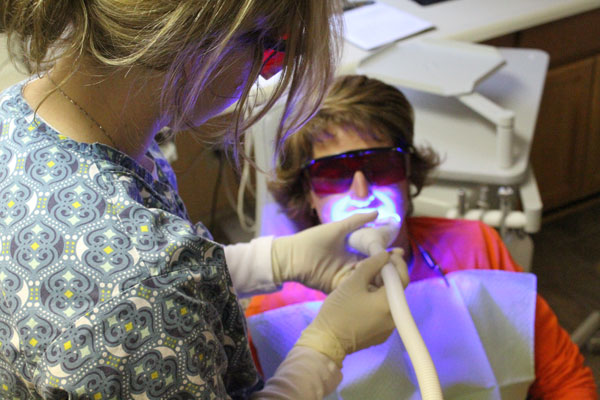Cosmetic Dental Procedures


Enhancing the smile’s aesthetic appearance can lead to increased self-confidence, improved social skills, and even a more positive outlook on life. Modern cosmetic dentistry merges advanced technology with fine art, and can often produce amazing results in less time than you would expect.
Teeth Whitening
3 Bleaching Options – If you are looking for a whiter, brighter smile, our office now offers 3 convenient options to bleach your teeth.
1) Immediate Results
If you would like immediate results in 1 hour, we offer opalescence BOOST power bleaching in which one of our doctors uses powerful 40% hydrogen peroxide to BOOST you to a whiter shade quickly.
2) At-Home Custom Trays
By making you custom-fit trays and giving you an Opalescence bleaching kit with carbamide peroxide gel in a 10%, 15%, 20%, or 35% concentration to allow you to bleach at home for a period of 2 weeks.
3) At-Home Opalescence
By purchasing a kit of Opalescence Trés White Bleaching Strips which allows you to bleach upper and lower arches for 10 days to whiten your smile. If you are interested in any of the above procedures, Please call to schedule a complimentary bleaching appointment to determine which option is best for you!
Bonding
Teeth that are chipped, discolored, uneven, stained or gapped. Bonding with composite resin. The composite resin used in bonding is a tooth-colored material that is applied directly to the enamel of teeth and shaped to correct the patient’s aesthetic concern. When exposed to a special ultraviolet light, the resin hardens into place. Porcelain veneers and crowns, while more expensive, last considerably longer than bonding.
Porcelain Laminates
Teeth that are chipped, discolored, uneven, stained or gapped. Teeth that are out-of-proportion in relation to the mouth. Teeth that are crooked or worn. Customized, wafer-thin veneers (also called porcelain laminates) are cemented directly onto the front of the tooth, resulting in a natural appearance that covers any irregularities or aesthetic concerns. Veneers are not an ideal choice for patients with tooth decay, advanced periodontal disease, or severe misalignment. In cases where veneers are not advisable, orthodontic treatments and porcelain crowns may be better choices.
Fillings
Tooth decay that has led to the development of a cavity, or small hole, in the tooth. Fillings. Your dentist will remove all areas of decay, and replace with a filling made of silver (amalgam) or composite resin. Composite resin fillings have surged in popularity because their appearance perfectly matches the natural appearance of teeth. In cases of more extensive decay, porcelain inlays and onlays are an advisable alternative.
Porcelain Inlays & Onlays
Tooth decay, weakened tooth structure, need for tooth restoration and reinforcement. After the decay is removed, your dentist will take an impression of the area to be restored. A dental laboratory works from this impression to create a restorative inlay or onlay, usually out of gold or porcelain, that fits perfectly on the tooth. Inlays cover one or more tooth surfaces, where onlays are used on the chewing surface of the tooth. The inlay or onlay is cemented securely into place, for an incredibly durable, stable tooth restoration. Porcelain is the preferred restorative material; it is extremely strong and can perfectly match the patient’s natural tooth color. Crowns may be the only alternative when tooth decay is in advanced stages.
Porcelain Crowns
Teeth that are chipped, cracked, badly decayed, or otherwise weakened. Porcelain Crowns maintain the aesthetic appearance of teeth by covering the entire visible surface of the tooth, while adding significant reinforcement and protection to the tooth. After removing all areas of decay, your dentist will take an impression of the tooth to be crowned and send it to a dental laboratory to create the crown. Crowns can be made of porcelain or gold. Porcelain crowns are extremely natural looking; virtually indistinguishable from other teeth, making them an ideal choice for visible teeth. Gold crowns pose no risk of chipping, and therefore are useful when crowning back teeth. Teeth that are badly decayed may require extraction, leaving bridges or implants as viable alternative treatments.
Porcelain Fixed Bridges
The inside of each tooth is filled with “pulp”, which carries the tooth’s blood supply and nerves. If bacteria gain access to the pulp, through a fracture or deep cavity, the pulp may become infected, leading to pain and a risk of tooth loss. In a root canal, your dentist will remove the infected pulp and replace it with a rubber sealant. The tooth is then covered with a protective cap, which reinforces the tooth against future fractures and enhances the tooth’s appearance. Root canals have an extremely high success rate in saving teeth that would otherwise be lost to infection. The only alternative to root canal therapy is tooth extraction.
Address
Hours of Operation
